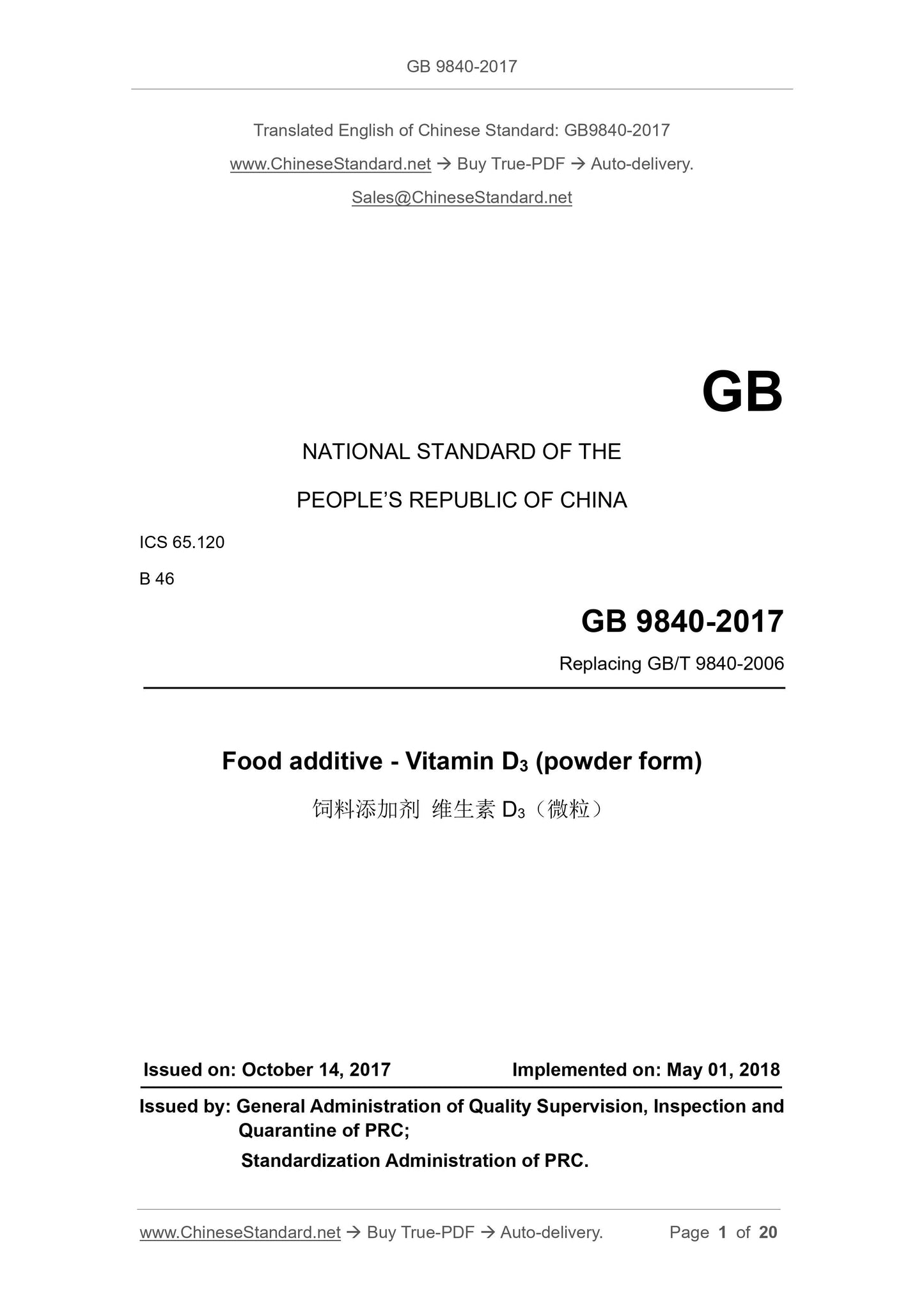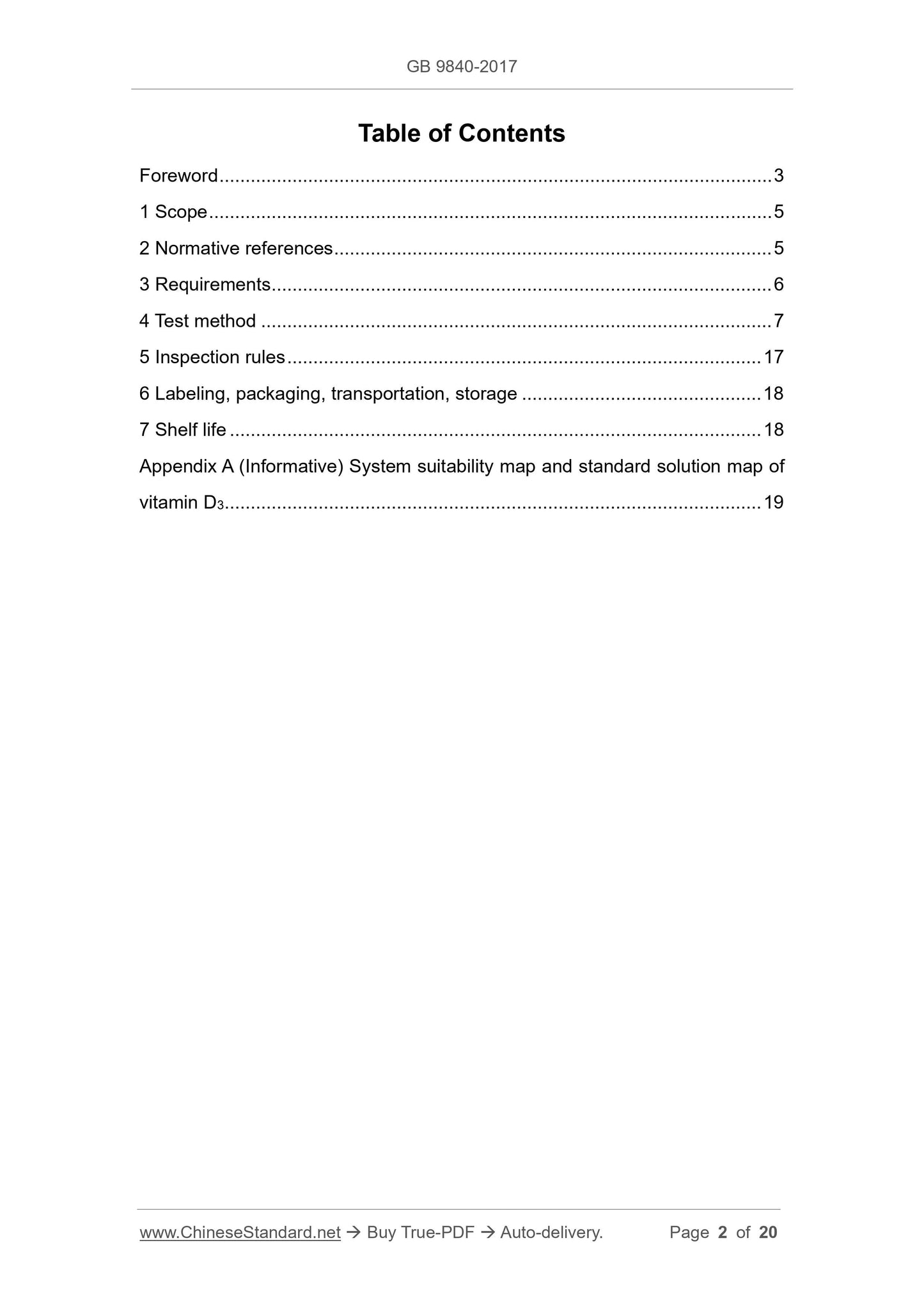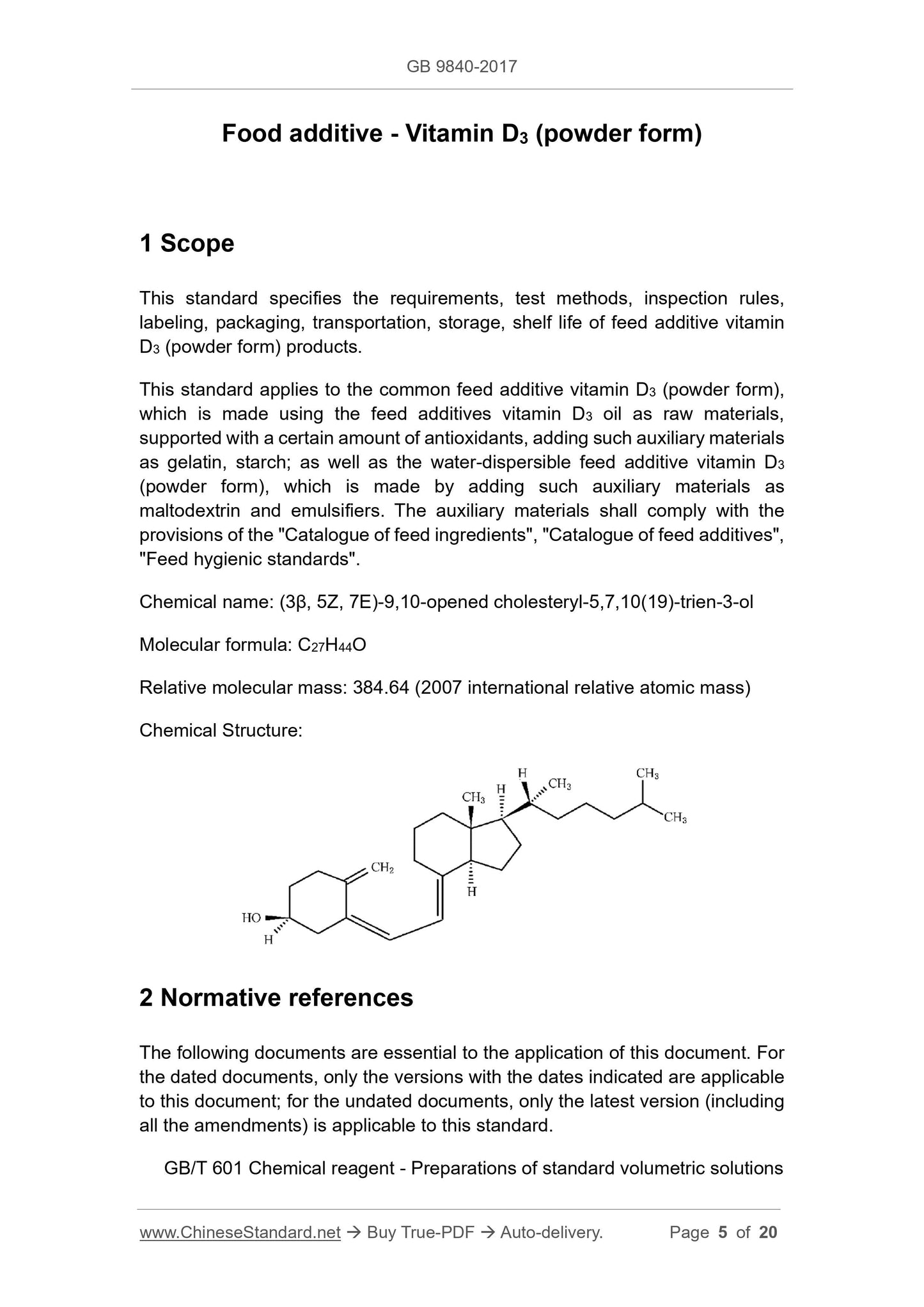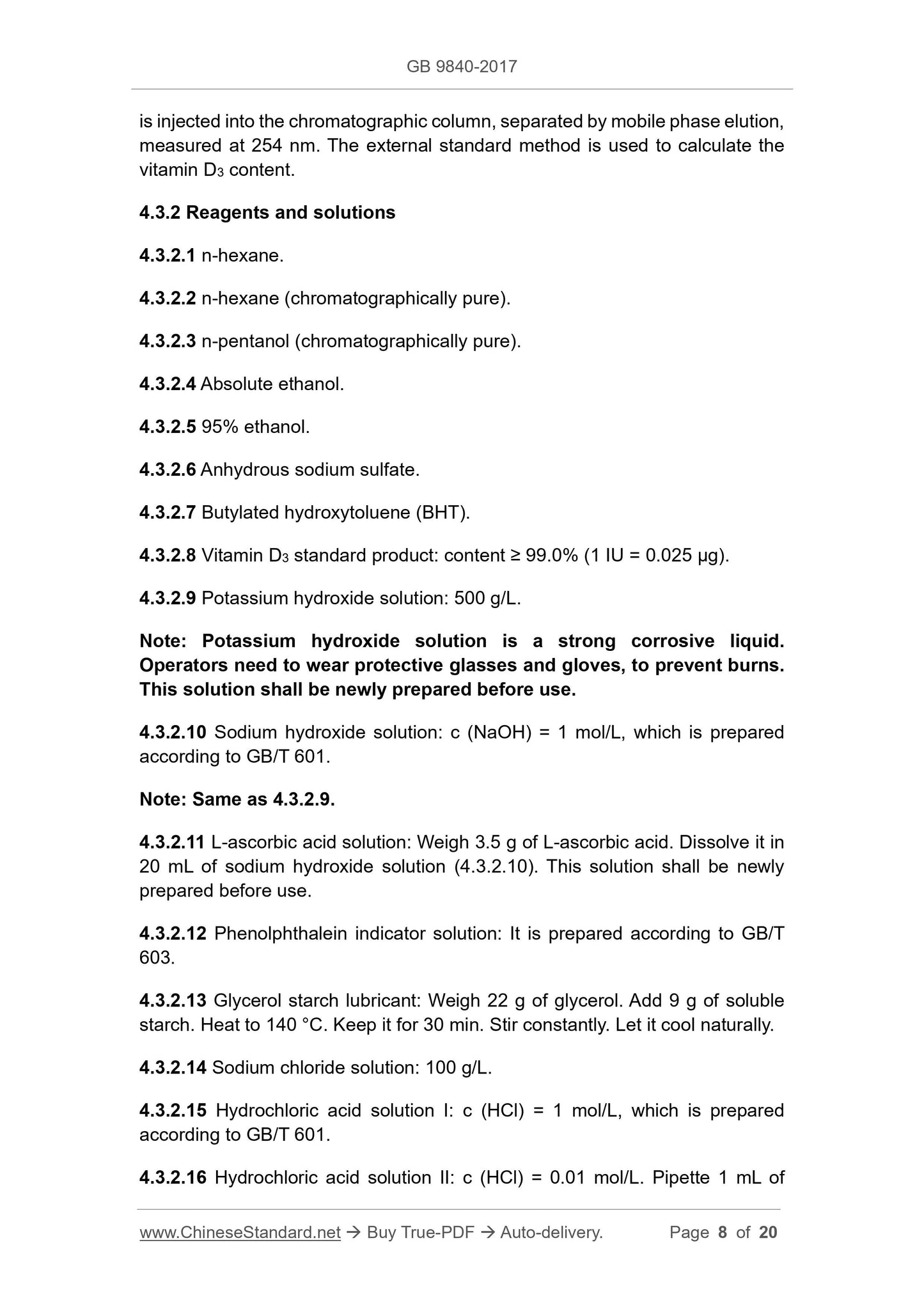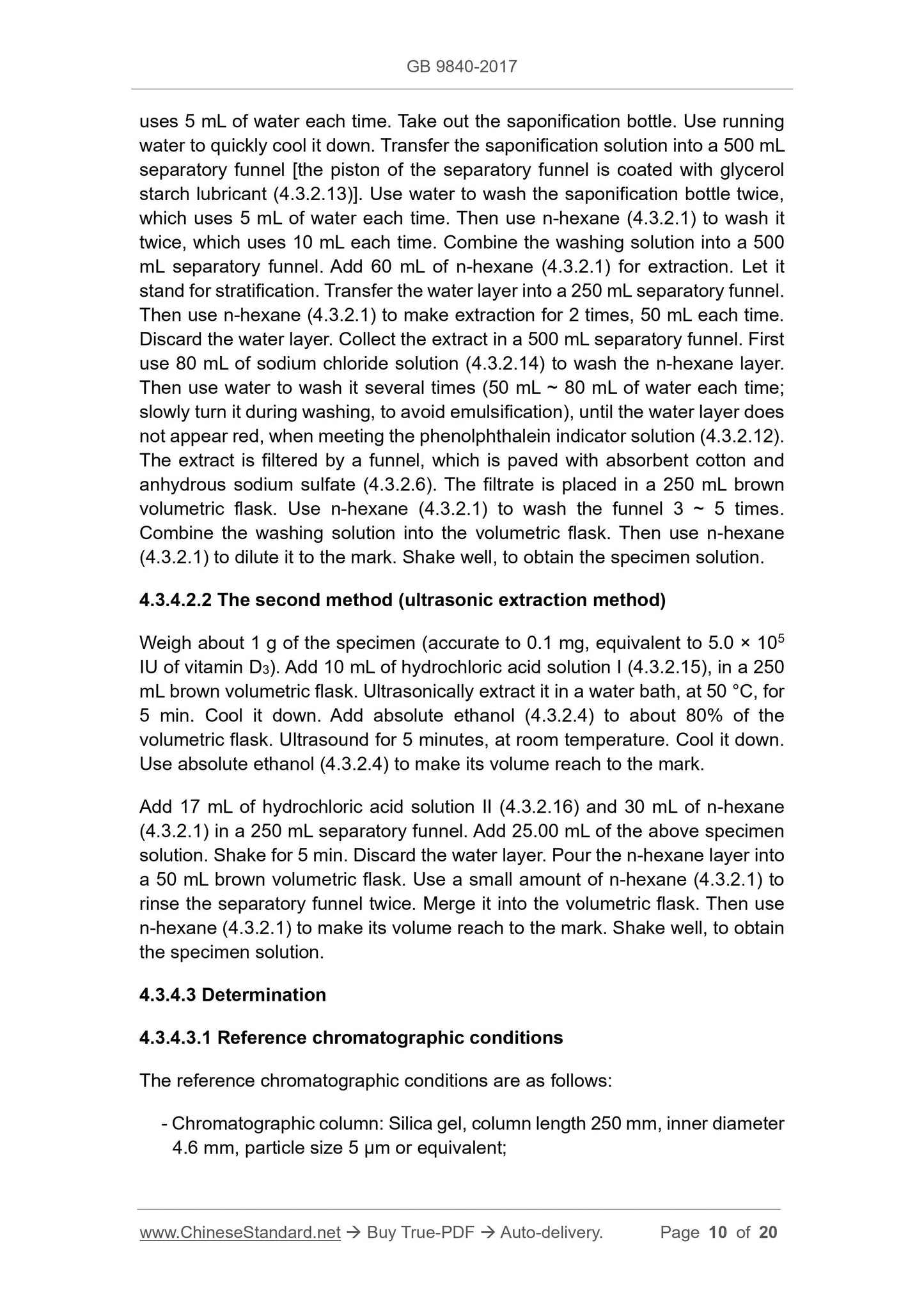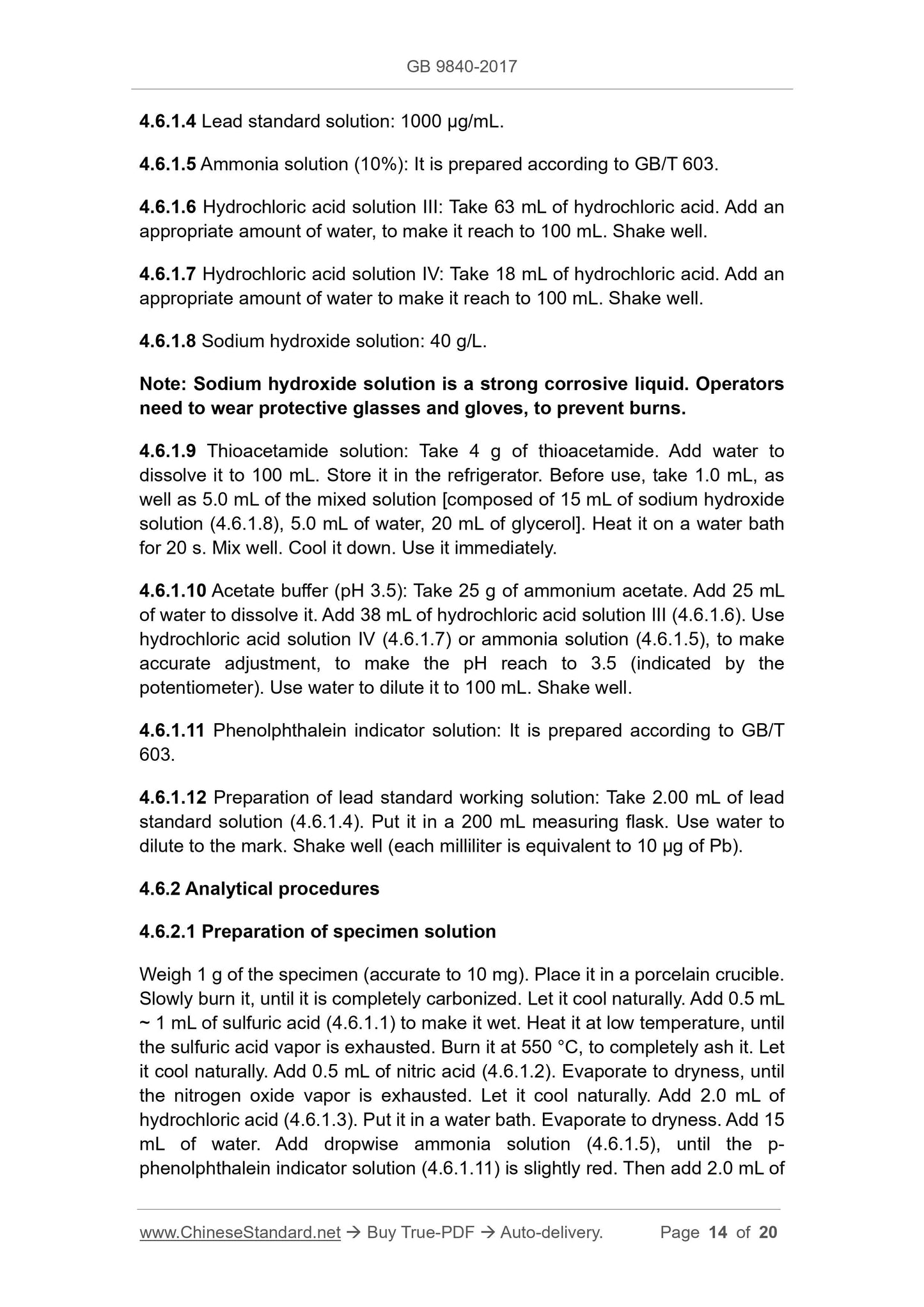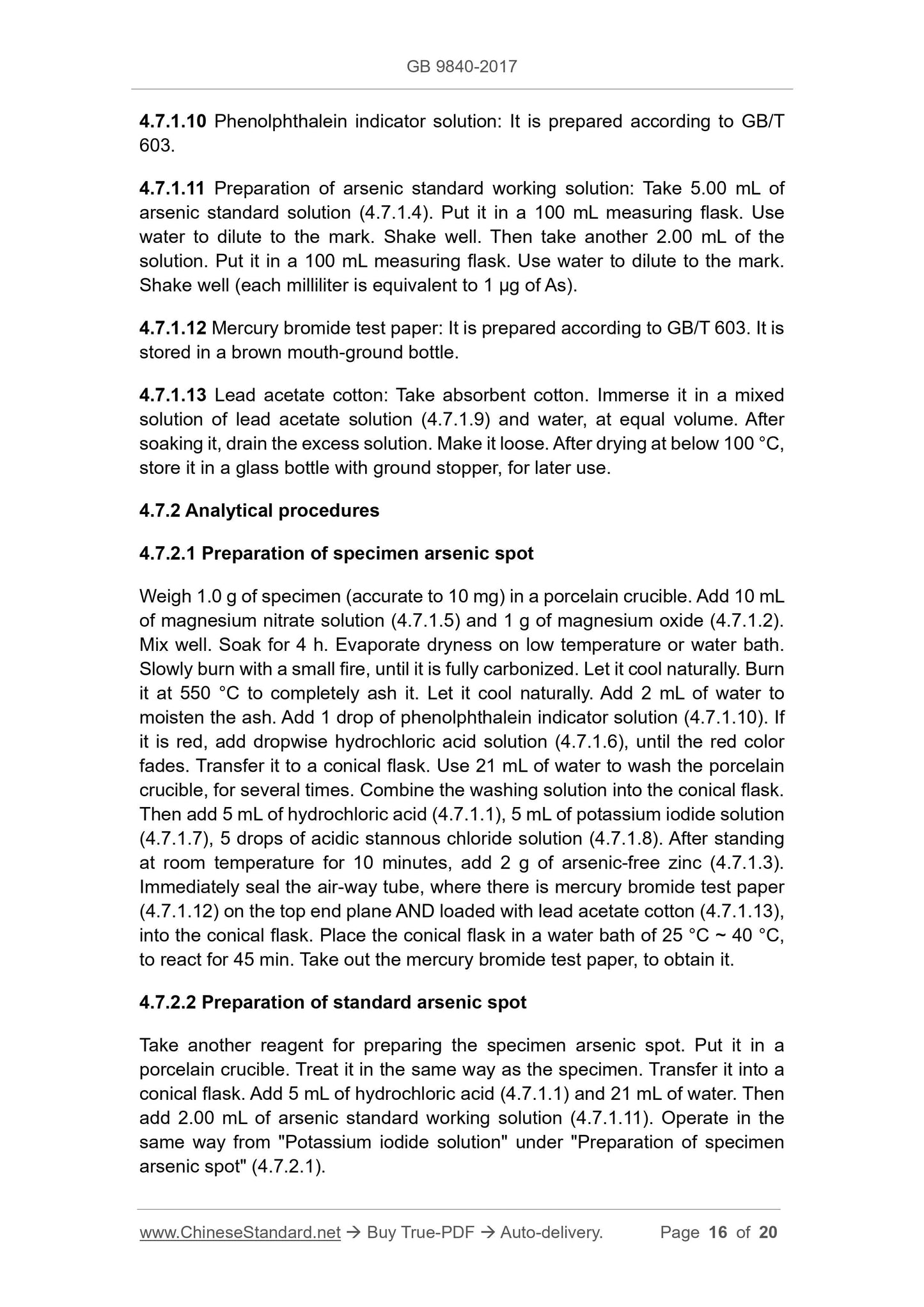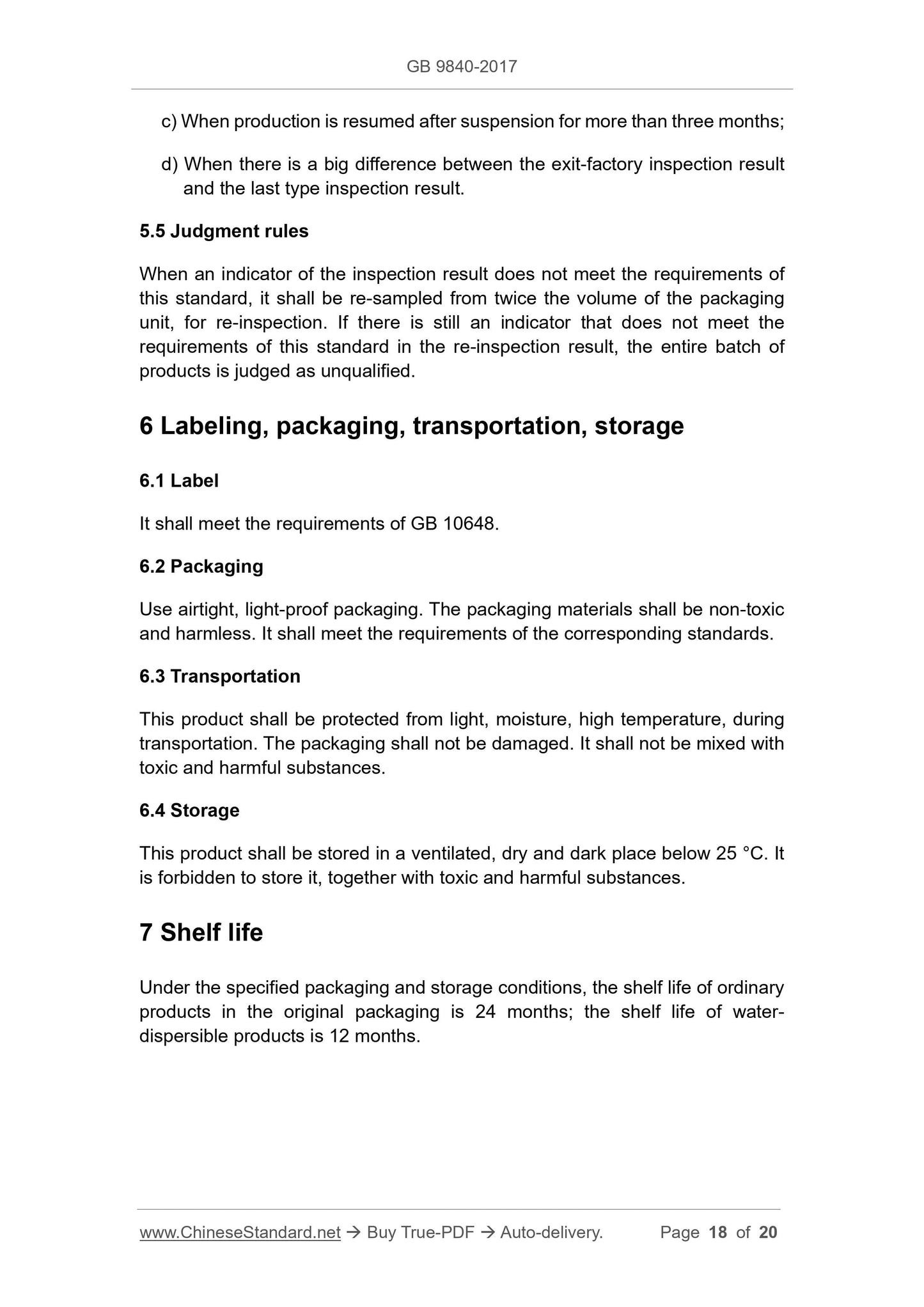1
/
of
8
PayPal, credit cards. Download editable-PDF & invoice in 1 second!
GB 9840-2017 English PDF (GB9840-2017)
GB 9840-2017 English PDF (GB9840-2017)
Regular price
$230.00 USD
Regular price
Sale price
$230.00 USD
Unit price
/
per
Shipping calculated at checkout.
Couldn't load pickup availability
Delivery: 3 seconds. Download true-PDF + Invoice.
Get QUOTATION in 1-minute: Click GB 9840-2017
Historical versions: GB 9840-2017
Preview True-PDF (Reload/Scroll if blank)
GB 9840-2017: Feed additive -- Vitamin D3 (powder form)
GB 9840-2017
GB
NATIONAL STANDARD OF THE
PEOPLE’S REPUBLIC OF CHINA
ICS 65.120
B 46
Replacing GB/T 9840-2006
Food additive - Vitamin D3 (powder form)
饲料添加剂 维生素 D3(微粒)
ISSUED ON: OCTOBER 14, 2017
IMPLEMENTED ON: MAY 01, 2018
Issued by: General Administration of Quality Supervision, Inspection and
Quarantine of PRC;
Standardization Administration of PRC.
Table of Contents
Foreword ... 3
1 Scope ... 5
2 Normative references ... 5
3 Requirements ... 6
4 Test method ... 7
5 Inspection rules ... 17
6 Labeling, packaging, transportation, storage ... 18
7 Shelf life ... 18
Appendix A (Informative) System suitability map and standard solution map of
vitamin D3 ... 19
Food additive - Vitamin D3 (powder form)
1 Scope
This standard specifies the requirements, test methods, inspection rules,
labeling, packaging, transportation, storage, shelf life of feed additive vitamin
D3 (powder form) products.
This standard applies to the common feed additive vitamin D3 (powder form),
which is made using the feed additives vitamin D3 oil as raw materials,
supported with a certain amount of antioxidants, adding such auxiliary materials
as gelatin, starch; as well as the water-dispersible feed additive vitamin D3
(powder form), which is made by adding such auxiliary materials as
maltodextrin and emulsifiers. The auxiliary materials shall comply with the
provisions of the "Catalogue of feed ingredients", "Catalogue of feed additives",
"Feed hygienic standards".
Chemical name: (3β, 5Z, 7E)-9,10-opened cholesteryl-5,7,10(19)-trien-3-ol
Molecular formula: C27H44O
Relative molecular mass: 384.64 (2007 international relative atomic mass)
Chemical Structure:
2 Normative references
The following documents are essential to the application of this document. For
the dated documents, only the versions with the dates indicated are applicable
to this document; for the undated documents, only the latest version (including
all the amendments) is applicable to this standard.
GB/T 601 Chemical reagent - Preparations of standard volumetric solutions
is injected into the chromatographic column, separated by mobile phase elution,
measured at 254 nm. The external standard method is used to calculate the
vitamin D3 content.
4.3.2 Reagents and solutions
4.3.2.1 n-hexane.
4.3.2.2 n-hexane (chromatographically pure).
4.3.2.3 n-pentanol (chromatographically pure).
4.3.2.4 Absolute ethanol.
4.3.2.5 95% ethanol.
4.3.2.6 Anhydrous sodium sulfate.
4.3.2.7 Butylated hydroxytoluene (BHT).
4.3.2.8 Vitamin D3 standard product: content ≥ 99.0% (1 IU = 0.025 µg).
4.3.2.9 Potassium hydroxide solution: 500 g/L.
Note: Potassium hydroxide solution is a strong corrosive liquid.
Operators need to wear protective glasses and gloves, to prevent burns.
This solution shall be newly prepared before use.
4.3.2.10 Sodium hydroxide solution: c (NaOH) = 1 mol/L, which is prepared
according to GB/T 601.
Note: Same as 4.3.2.9.
4.3.2.11 L-ascorbic acid solution: Weigh 3.5 g of L-ascorbic acid. Dissolve it in
20 mL of sodium hydroxide solution (4.3.2.10). This solution shall be newly
prepared before use.
4.3.2.12 Phenolphthalein indicator solution: It is prepared according to GB/T
603.
4.3.2.13 Glycerol starch lubricant: Weigh 22 g of glycerol. Add 9 g of soluble
starch. Heat to 140 °C. Keep it for 30 min. Stir constantly. Let it cool naturally.
4.3.2.14 Sodium chloride solution: 100 g/L.
4.3.2.15 Hydrochloric acid solution I: c (HCl) = 1 mol/L, which is prepared
according to GB/T 601.
4.3.2.16 Hydrochloric acid solution II: c (HCl) = 0.01 mol/L. Pipette 1 mL of
uses 5 mL of water each time. Take out the saponification bottle. Use running
water to quickly cool it down. Transfer the saponification solution into a 500 mL
separatory funnel [the piston of the separatory funnel is coated with glycerol
starch lubricant (4.3.2.13)]. Use water to wash the saponification bottle twice,
which uses 5 mL of water each time. Then use n-hexane (4.3.2.1) to wash it
twice, which uses 10 mL each time. Combine the washing solution into a 500
mL separatory funnel. Add 60 mL of n-hexane (4.3.2.1) for extraction. Let it
stand for stratification. Transfer the water layer into a 250 mL separatory funnel.
Then use n-hexane (4.3.2.1) to make extraction for 2 times, 50 mL each time.
Discard the water layer. Collect the extract in a 500 mL separatory funnel. First
use 80 mL of sodium chloride solution (4.3.2.14) to wash the n-hexane layer.
Then use water to wash it several times (50 mL ~ 80 mL of water each time;
slowly turn it during washing, to avoid emulsification), until the water layer does
not appear red, when meeting the phenolphthalein indicator solution (4.3.2.12).
The extract is filtered by a funnel, which is paved with absorbent cotton and
anhydrous sodium sulfate (4.3.2.6). The filtrate is placed in a 250 mL brown
volumetric flask. Use n-hexane (4.3.2.1) to wash the funnel 3 ~ 5 times.
Combine the washing solution into the volumetric flask. Then use n-hexane
(4.3.2.1) to dilute it to the mark. Shake well, to obtain the specimen solution.
4.3.4.2.2 The second method (ultrasonic extraction method)
Weigh about 1 g of the specimen (accurate to 0.1 mg, equivalent to 5.0 × 105
IU of vitamin D3). Add 10 mL of hydrochloric acid solution I (4.3.2.15), in a 250
mL brown volumetric flask. Ultrasonically extract it in a water bath, at 50 °C, for
5 min. Cool it down. Add absolute ethanol (4.3.2.4) to about 80% of the
volumetric flask. Ultrasound for 5 minutes, at room temperature. Cool it down.
Use absolute ethanol (4.3.2.4) to make its volume reach to the mark.
Add 17 mL of hydrochloric acid solution II (4.3.2.16) and 30 mL of n-hexane
(4.3.2.1) in a 250 mL separatory funnel. Add 25.00 mL of the above specimen
solution. Shake for 5 min. Discard the water layer. Pour the n-hexane layer into
a 50 mL brown volumetric flask. Use a small amount of n-hexane (4.3.2.1) to
rinse the separatory funnel twice. Merge it into the volumetric flask. Then use
n-hexane (4.3.2.1) to make its volume reach to the mark. Shake well, to obtain
the specimen solution.
4.3.4.3 Determination
4.3.4.3.1 Reference chromatographic conditions
The reference chromatographic conditions are as follows:
- Chromatographic column: Silica gel, column length 250 mm, inner diameter
4.6 mm, particle size 5 μm or equivalent;
4.6.1.4 Lead standard solution: 1000 μg/mL.
4.6.1.5 Ammonia solution (10%): It is prepared according to GB/T 603.
4.6.1.6 Hydrochloric acid solution III: Take 63 mL of hydrochloric acid. Add an
appropriate amount of water, to make it reach to 100 mL. Shake well.
4.6.1.7 Hydrochloric acid solution IV: Take 18 mL of hydrochloric acid. Add an
appropriate amount of water to make it reach to 100 mL. Shake well.
4.6.1.8 Sodium hydroxide solution: 40 g/L.
Note: Sodium hydroxide solution is a strong corrosive liquid. Operators
need to wear protective glasses and gloves, to prevent burns.
4.6.1.9 Thioacetamide solution: Take 4 g of thioacetamide. Add water to
dissolve it to 100 mL. Store it in the refrigerator. Before use, take 1.0 mL, as
well as 5.0 mL of the mixed solution [composed of 15 mL of sodium hydroxide
solution (4.6.1.8), 5.0 mL of water, 20 mL of glycerol]. Heat it on a water bath
for 20 s. Mix well. Cool it down. Use it immediately.
4.6.1.10 Acetate buffer (pH 3.5): Take 25 g of ammonium acetate. Add 25 mL
of water to dissolv...
Get QUOTATION in 1-minute: Click GB 9840-2017
Historical versions: GB 9840-2017
Preview True-PDF (Reload/Scroll if blank)
GB 9840-2017: Feed additive -- Vitamin D3 (powder form)
GB 9840-2017
GB
NATIONAL STANDARD OF THE
PEOPLE’S REPUBLIC OF CHINA
ICS 65.120
B 46
Replacing GB/T 9840-2006
Food additive - Vitamin D3 (powder form)
饲料添加剂 维生素 D3(微粒)
ISSUED ON: OCTOBER 14, 2017
IMPLEMENTED ON: MAY 01, 2018
Issued by: General Administration of Quality Supervision, Inspection and
Quarantine of PRC;
Standardization Administration of PRC.
Table of Contents
Foreword ... 3
1 Scope ... 5
2 Normative references ... 5
3 Requirements ... 6
4 Test method ... 7
5 Inspection rules ... 17
6 Labeling, packaging, transportation, storage ... 18
7 Shelf life ... 18
Appendix A (Informative) System suitability map and standard solution map of
vitamin D3 ... 19
Food additive - Vitamin D3 (powder form)
1 Scope
This standard specifies the requirements, test methods, inspection rules,
labeling, packaging, transportation, storage, shelf life of feed additive vitamin
D3 (powder form) products.
This standard applies to the common feed additive vitamin D3 (powder form),
which is made using the feed additives vitamin D3 oil as raw materials,
supported with a certain amount of antioxidants, adding such auxiliary materials
as gelatin, starch; as well as the water-dispersible feed additive vitamin D3
(powder form), which is made by adding such auxiliary materials as
maltodextrin and emulsifiers. The auxiliary materials shall comply with the
provisions of the "Catalogue of feed ingredients", "Catalogue of feed additives",
"Feed hygienic standards".
Chemical name: (3β, 5Z, 7E)-9,10-opened cholesteryl-5,7,10(19)-trien-3-ol
Molecular formula: C27H44O
Relative molecular mass: 384.64 (2007 international relative atomic mass)
Chemical Structure:
2 Normative references
The following documents are essential to the application of this document. For
the dated documents, only the versions with the dates indicated are applicable
to this document; for the undated documents, only the latest version (including
all the amendments) is applicable to this standard.
GB/T 601 Chemical reagent - Preparations of standard volumetric solutions
is injected into the chromatographic column, separated by mobile phase elution,
measured at 254 nm. The external standard method is used to calculate the
vitamin D3 content.
4.3.2 Reagents and solutions
4.3.2.1 n-hexane.
4.3.2.2 n-hexane (chromatographically pure).
4.3.2.3 n-pentanol (chromatographically pure).
4.3.2.4 Absolute ethanol.
4.3.2.5 95% ethanol.
4.3.2.6 Anhydrous sodium sulfate.
4.3.2.7 Butylated hydroxytoluene (BHT).
4.3.2.8 Vitamin D3 standard product: content ≥ 99.0% (1 IU = 0.025 µg).
4.3.2.9 Potassium hydroxide solution: 500 g/L.
Note: Potassium hydroxide solution is a strong corrosive liquid.
Operators need to wear protective glasses and gloves, to prevent burns.
This solution shall be newly prepared before use.
4.3.2.10 Sodium hydroxide solution: c (NaOH) = 1 mol/L, which is prepared
according to GB/T 601.
Note: Same as 4.3.2.9.
4.3.2.11 L-ascorbic acid solution: Weigh 3.5 g of L-ascorbic acid. Dissolve it in
20 mL of sodium hydroxide solution (4.3.2.10). This solution shall be newly
prepared before use.
4.3.2.12 Phenolphthalein indicator solution: It is prepared according to GB/T
603.
4.3.2.13 Glycerol starch lubricant: Weigh 22 g of glycerol. Add 9 g of soluble
starch. Heat to 140 °C. Keep it for 30 min. Stir constantly. Let it cool naturally.
4.3.2.14 Sodium chloride solution: 100 g/L.
4.3.2.15 Hydrochloric acid solution I: c (HCl) = 1 mol/L, which is prepared
according to GB/T 601.
4.3.2.16 Hydrochloric acid solution II: c (HCl) = 0.01 mol/L. Pipette 1 mL of
uses 5 mL of water each time. Take out the saponification bottle. Use running
water to quickly cool it down. Transfer the saponification solution into a 500 mL
separatory funnel [the piston of the separatory funnel is coated with glycerol
starch lubricant (4.3.2.13)]. Use water to wash the saponification bottle twice,
which uses 5 mL of water each time. Then use n-hexane (4.3.2.1) to wash it
twice, which uses 10 mL each time. Combine the washing solution into a 500
mL separatory funnel. Add 60 mL of n-hexane (4.3.2.1) for extraction. Let it
stand for stratification. Transfer the water layer into a 250 mL separatory funnel.
Then use n-hexane (4.3.2.1) to make extraction for 2 times, 50 mL each time.
Discard the water layer. Collect the extract in a 500 mL separatory funnel. First
use 80 mL of sodium chloride solution (4.3.2.14) to wash the n-hexane layer.
Then use water to wash it several times (50 mL ~ 80 mL of water each time;
slowly turn it during washing, to avoid emulsification), until the water layer does
not appear red, when meeting the phenolphthalein indicator solution (4.3.2.12).
The extract is filtered by a funnel, which is paved with absorbent cotton and
anhydrous sodium sulfate (4.3.2.6). The filtrate is placed in a 250 mL brown
volumetric flask. Use n-hexane (4.3.2.1) to wash the funnel 3 ~ 5 times.
Combine the washing solution into the volumetric flask. Then use n-hexane
(4.3.2.1) to dilute it to the mark. Shake well, to obtain the specimen solution.
4.3.4.2.2 The second method (ultrasonic extraction method)
Weigh about 1 g of the specimen (accurate to 0.1 mg, equivalent to 5.0 × 105
IU of vitamin D3). Add 10 mL of hydrochloric acid solution I (4.3.2.15), in a 250
mL brown volumetric flask. Ultrasonically extract it in a water bath, at 50 °C, for
5 min. Cool it down. Add absolute ethanol (4.3.2.4) to about 80% of the
volumetric flask. Ultrasound for 5 minutes, at room temperature. Cool it down.
Use absolute ethanol (4.3.2.4) to make its volume reach to the mark.
Add 17 mL of hydrochloric acid solution II (4.3.2.16) and 30 mL of n-hexane
(4.3.2.1) in a 250 mL separatory funnel. Add 25.00 mL of the above specimen
solution. Shake for 5 min. Discard the water layer. Pour the n-hexane layer into
a 50 mL brown volumetric flask. Use a small amount of n-hexane (4.3.2.1) to
rinse the separatory funnel twice. Merge it into the volumetric flask. Then use
n-hexane (4.3.2.1) to make its volume reach to the mark. Shake well, to obtain
the specimen solution.
4.3.4.3 Determination
4.3.4.3.1 Reference chromatographic conditions
The reference chromatographic conditions are as follows:
- Chromatographic column: Silica gel, column length 250 mm, inner diameter
4.6 mm, particle size 5 μm or equivalent;
4.6.1.4 Lead standard solution: 1000 μg/mL.
4.6.1.5 Ammonia solution (10%): It is prepared according to GB/T 603.
4.6.1.6 Hydrochloric acid solution III: Take 63 mL of hydrochloric acid. Add an
appropriate amount of water, to make it reach to 100 mL. Shake well.
4.6.1.7 Hydrochloric acid solution IV: Take 18 mL of hydrochloric acid. Add an
appropriate amount of water to make it reach to 100 mL. Shake well.
4.6.1.8 Sodium hydroxide solution: 40 g/L.
Note: Sodium hydroxide solution is a strong corrosive liquid. Operators
need to wear protective glasses and gloves, to prevent burns.
4.6.1.9 Thioacetamide solution: Take 4 g of thioacetamide. Add water to
dissolve it to 100 mL. Store it in the refrigerator. Before use, take 1.0 mL, as
well as 5.0 mL of the mixed solution [composed of 15 mL of sodium hydroxide
solution (4.6.1.8), 5.0 mL of water, 20 mL of glycerol]. Heat it on a water bath
for 20 s. Mix well. Cool it down. Use it immediately.
4.6.1.10 Acetate buffer (pH 3.5): Take 25 g of ammonium acetate. Add 25 mL
of water to dissolv...
Share
